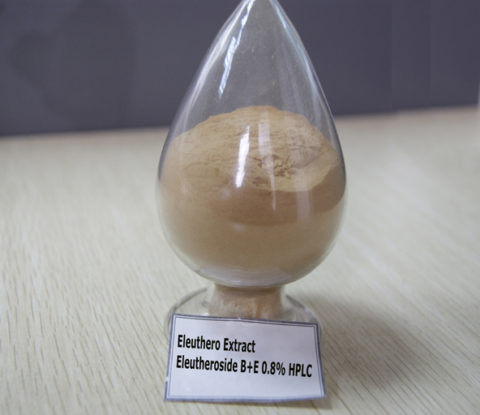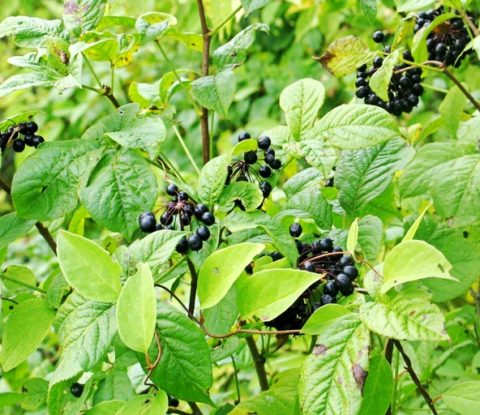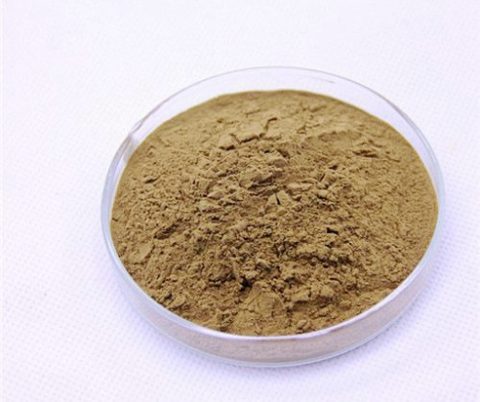
Eleuthero Extract
Siberian Ginseng Extract
【Latin name】: Eleutherococcus senticosus
【Part used】: Root and stem
【Active ingredient】: Eleutheroside B and E
【Cas No】:118-34-3(Eleutheroside B);39432-56-9(Eleutheroside E)
【Molecular formula】: EleutherosideB.(C17H20O10);EleutherosideE.(C34H46O18)
【Molecular Weight】: Eleutheroside B.(385.33)Eleutheroside E.(742.71)
【Specification】: 0.8%,1%,1.2% HPLC
【Particle size】: 95% pass 80 mesh size
【Appearance】: Yellowish brown fine powder
Brief Introduction
Eleutherococcus senticosus (synonymous with Acanthopanax senticosus and sometimes referred to as Siberian ginsengor Ciwujia) is an Adaptogen that has traditional usage in asian countries (China, Japan, Korea, and eastern Russia) although its popularity is lesser than that of asian ginseng (Panax ginseng). It’s properties according to Traditional Chinese Medicine are “invigorating qi and strengthening the spleen, tonifying kidney to relieve mental strain” whereas usage in Siberia (from where the plant appears to originate) and Russia tends to be associated with promoting physical endurance, non-specific immunity, and longevity.
Traditional usage of eleuthero involves eating the root or its extracts in the dosage range of 9-27g a day (chinese medicine) or 6-12g a day (American sources, more modern); these are both higher than a more commonly recommended 2-4 grams of eleuthero root. The root itself is a light brown, free-flowing powder that has a somewhat sweet flavour with bitter undertones. Eleuthero is a root that has been used in Traditional Chinese Medicine mostly for its anti-fatigue purposes and some pro-vitality and longevity purposes in older individuals as well.
Chemical composition
The roots and/or leaves of eleuthero, the main component used, tend to contain:
-Eleutheroside B, E, E1, and E2 (lignans) which are structurally based off of episyringaresinol. Syringoresinol is also present, and Eleutheroside B is merely syringin and appears to be the main bioactive lignan. Total eleutherosides appear to range from 0.6-0.9% of the dry weight of the root and usually 0.31% and 0.51% are reference levels for eleutheroside B and E, respectively.
-Ciwujianosides (A1, A2, A3, A4, B, C1, C2, C3, C4, D1, D2 D3, E)
-Acanthopanaxosides A-C (triterpene saponins) and E
-Copteroside B
-Silphioside F
-Sessiloside
-Tauroside H1
-Eleutherazine A and B (Aerial parts)
-Oplopanone B (Aerial parts)
-Mesembryanthemoidigenic acid (as 3-O-alpha-rhamnopyranosyl- (1-2)-alpha-arabinopyranosyl)
-Chiisanoside
-Hederasaponin B and its glycoside, 3-O-beta-D-glucuronopyranoside 6′-O-methyl ester
-Gypsogenin (as 3-O-beta-D-glucuronopyranoside)
-Sesamin (lignan)
-(+)-pinoresinol-di-O-β-d-glucoside and (+)-pinoresinol-O-β-d-glucoside
-Isofraxidin (as 7-O-β-D-glucoside), structurally related to scopoletin
-Quercetin, quercitrin, and rutin
-Chlorogenic Acid and caffeic acid derivatives
Eleuthero contains both saponins and lignans, with a large amount (over 200) different molecules being detected as either aglycones or glycosides. The main bioactive appears to be Eleutheroside B (Syringin) and Eleuetheroside E (a syringaresinol diglucoside) and these are not structurally related to Panax ginseng bioactives.
Pharmacological Benefits
1.Neurological effects
1). Mechanisms
Ingestion of 2000mg/kg eleuthero to mice for a week appears to exert anti-depressive effects and associated with whole-brain upregulation of cAMP response element-binding and monoamines (serotonin, noradrenaline, and dopamine). This increase in catecholamines has been noted elsewhere (measured in the hypothalamus) at 100-250mg/kg intake in rats and an increase in noradrenaline turnover has been noted in the hypothalamus as well. The mechanisms underlying the increase in catecholamines are not yet known, but may be related to modulation of catechol-o-methyltransferase (one of the target enzymes from Green Tea Catechins).
When looking at c-Fos immunoreactivity, there appears to be a larger induction of imunoreactivity following oral ingestion of 100mg/kg eleuthero in the paraventricular nuclei and the caudal portion of the supraoptic nuceli; two regions involed in chronic stress.
Eleuthero appears to be catecholaminergic in nature (similar to the Adaptogen Muira puama) and able to increase neurotransmitters. The dosage this occurs at may be practically relevant to supplemental doses (100-250mg/kg of the root extract to a rat is 16-40mg/kg for a human, and a 150lb human would need 1.1-2.7g of the dry root.
2). Cognition
Syringin has been implicated in promoting neurite outgrowth in PC12 cells, although to a lesser degree relative to (+)-syringaresinol diglucoside and aucubin (from Aucuba japonica). Possible positive growth on neurites, but not well studied or replicated. Some literature behind a russian paywall suggesting an increase in cognition that cannot be assessed.
3). Stress
It is thought that the release of Neuropeptide Y seen with adaptogens can be used as a biomarker of stress reduction from adaptogens, this was subsequently tested with Adapt232 (Schisandra chinensis, Rhodiola Rosea, and eleuthero) in military personnel (prone to cardiovascular stress responses due to chronic stress to a higher level than seen in the average population which is correlated with trauma) noted reductions in blood pressure (systolic and diastolic) and heart rate with treatment which was said to be due to neuropeptide Y regulation (it is not clear if this study measured NPY).
This adaptogen complex (ADAPT232) also appears to induce HSP72 induction from neuroglia which has been detected in the serum of rats given the combination therapy prior to a swimming stress test. Neuropeptide Y appears to be related to chronic stress, and it is thought that this is a molecular target of adaptogenic compounds. Studies assessing this tend to use ADAPT232 (Eleuthero with Rhodiola and Schisandra chinensis) and there is insufficient evidence to evaluate eleuthero in isolation on this parameter.
4). Sleep
One study assessing isolated eleutheroside E at 10 or 50mg/kg (injections) is able to normalize a fair bit of the alterations observed during sleep deprivation in mice and a normalization of the changes in erythropoeisis induced by sleep deprivation (suppression, normally) were noted to occur with adaptogens including eleuthero supplementation in mice thought to be secondary to modulating neuroamines. May aid function in sleep deprivation, although there are no studies assessing the potency of eleuthero relative to other agents for reference.
5). Neuroprotection
Eleuthero (fruit extract at 1-40µg/mL) has been noted to induce the enzyme known as heme oxygenase 1 (HO-1) secondary to p38-CREB induced translocation of Nrf2 (p38 MAPK also phosphorylated). HO-1 is a rate-limiting enzyme of antiinflammation in many cells including microglia which reduced the expression of proinflammatory mediators like iNOS and COX-2. The induction of HO-1 from eleuthero is concentration-dependent and up to 5-7 fold control cells at 40µg/mL (HT22 and BV2 cells, respectively). Eleuthero fruit extracts have also been noted to reduce glutamate-induced oxidation in microglia and preserve cell viability in the presence of excitotoxicity in a concentration dependent manner (40µg/mL preserving approximately 80% of viability).
In rat corticol neurons damaged by amyloid β(25-35), both main eleuterosides (B and E) and isofraxidin showed protective effects in the concentration range of 1-10μM and both the butanolic (100μg/mL) and water (1-100μg/mL) extracts of the roots in general was able to normalize damage (similar to the active control of 100ng/mL NGF). This has been noted elsewhere where eleutheroside B was again the most protective agent.
In vitro, there appear to be neuroprotective effects of eleuthero root extracts related to antioxidant enzyme induction. These might be occurring at feasible concentrations (no brain pharmacokinetic data, however)
Oral ingestion of 30, 100, and 300mg/kg eleuthero (stem bark with 0.486+/-0.046% eleutheroside E) was able to preserve 3.5%, 25.9% and 53.1% of hippocampal cell viability when rats were subject to ischemia/reperfusion and then give the oral dose of eleuthero immediately after and 90 minutes after surgery. This study also noted that with the preservation of hippocampal cells came preservation of spatial memory in a Y-Maze test, with the highest dose inhibiting 81.9% of the losses in spatial memory.
The injury induced increase in inflammatory parameters (COX2 induction and activated microglia) has also been noted to be markedly attenuated 7 days after the injury as assessed by histological examination, and these protective effects have been replicated elsewhere but with 100mg/kg injections of eleutherococcus.
Has demonstrated rehabilitative effects on one animal model of cognitive damage, with the higher tested dose (300mg/kg in rats, human estimated dose of 48mg/kg) being quite profoundly protective via mixed antiinflammatory and antioxidative.
6). Bipolar Disorder
In a trial on adolescents already using lithium for bipolar disorder and then given either eleuthero root (750mg thrice a day for 2250mg total) or fluoxetine (20mg) for 6 weeks, there were no apparent differences in remission (51.4% vs 48.7%) or response rates (67.6% vs 71.8%) between groups although there appeared to be less side-effects assocaited with eleutheroin comparison to fluoxetine. A lone trial suggesting that adding high dose eleuthero to lithium was as effective as adding fluoxetine to lithium for the treatment of bipolar disorder.
2.Skeletal Muscle and Physical Performance
1). Mechanisms
170mg/kg of a 70% methanolic extract has shown anti-oxidative effects in the skeletal muscle of mice during exercise.
2). Fatigue and Performance
When rats were subject to prolonged swimming, a water extract of the stem (500mg/kg for 25 days) appears to have anti-fatigue effects which was thought to be due to the (+)-syringaresinol-di-O-beta-D-glucoside component (similarly effective at 50mg/kg). This has been noted elsewhere, where five different extracts of eleuthero were tested with the one lowest in eleutherosides B and E failing to have any effect and the one with the highest Eleutheroside E content (3.32% of the 1g/kg dose) outperfoming red Panax ginseng; a time-dependent effect was noted, with days 5 and 7 outperforming day 1 and elsewhere in mice swimming performance has been enhanced with extracts containing high levels of Eleutheroside E and E2 but to a slightly lesser potency than red ginseng.
Anti-fatigue effects seem to be related to Eleutheroside E and (+)-syringaresinol-di-O-beta-D-glucoside components. When comparing eleuthero to panax ginseng they seem somewhat comparable in efficacy.
When tested in humans (n=9) subject to a 75% VO2 max cycle to exhaustion, 800mg of eleuthero root (0.11% eleutheroside B and 0.12% eleutheroside E) in two divided doses with meals for 8 weeks was associated with improvements in time to exhaustion (placebo improved 6%, eleuthero improved 25.5%) paired with an increase in VO2, heart rate (4.3%), free fatty acids (19.5%) and respiratory exchange ratio (2.7%) with a decrease in glucose during exercise (6.7%) with no influence on the rate of perceived exertion. This increase in lipid oxidation has been noted elsewhere with the herb, although with a reduced heart rate.
Performance enhancement has been noted elsewhere with a 35% ethanolic extract of eleuthero in liquid form (Taiga Wurzel at 25 drops daily) for 30 days prior to a VO2 max test where max VO2 in relation to body weight increased by 8.6% (without comparison to body weight, the benefit was not statistically significant) and max VE increased by 7.4%; this study failed to note changes in the respiratory quotient or heart rate, and eleuthero outperformed Echinacea (purpurea) and elsewhere a VO2 max test on a weighted cycle ergometer noted a 23.3% increase in workload relative to control, which outperformed the 7.3% increase in placebo (relative to control) after 8 days of ingesting 4mL of eleuthero tincture (300mg plant extract equivalent) in two divided doses of 2mL in the morning and PM. Time to exhaustion was 5.4% greater in placebo and 16.3% greater with eleuthero.
Despite the above three trials, one review conluded no significant effects associated with eleuthero due to the aforementioned studies being low in methodological quality and other trials of higher quality showing no effects. Two trials using ENDUROX (brand name) failed to find any influence on heart rate or fat oxidation during submaximal exercise (800mg eleuthero leaf) and no influence on fat oxidation or oxygen consumption with 1200mg eleuthero leaf extract, respectively. One study failed to find an effect with 1000mg of the root extract failed to find an effect on VO2 max or grip strength (instead noting an increase in pectoral and leg strength by 15% and 13%) while the other studies noted that 3.4mL of eleuthero root extract tincture failed to find a significant influence on fat oxidation and oxygen consumption and 1,200mg of the leaf extract has also failed again during submaximal exercise.
Evidence is mixed currently, and conclusions are hard to draw as although the studies suggesting promise with eleuthero supplementation are less statistically robust (poor metholody and sample sizes) other more well controlled studies seem to evaluate submaximal exercise more, whereas the promising studies were in regards to anti-fatigue effects during maximal exercise. At this moment in time, a clear performance enhancing effect of eleuthero is not present but performance enhancement cannot be ruled out yet.
3). Exercise-induced Immunosuppression
Eleuthero (cortex at 1g/kg bodyweight in mice for nine days) has been noted to suppress exercise-induced corticosterone increases to a similar degree as the active control of red Panax ginseng and some increases have been noted in Natural Killer cell activity, although for the latter it was unreliable (two of five tested herb samples abolished the decrease seen with exercise) and did not appear to be related to the Eleutheroside B and E content.
One study noted that consumption of eleuthero in humans (Taiga Wurzel at 25 drops daily, amount of bioactives unknown but the tincture being a 1:1 35% ethanolic extract or the root) increasing spontaneous and LF-7 induced blastic transformation of lymphocytes and this T-cell stimulatory effect has been noted elsewhere when exercise was not a factor.






